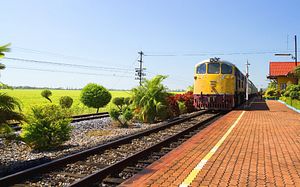Thailand has signed bilateral agreements with China and Japan to build two railway trunk lines across the country. One line, to be built with Chinese loans and technology, will link Bangkok and Map Ta Phut in the south through Laos to Kunming, Yunnan, in the north. The second line, to be built with Japanese capital and technology, will cross several countries on the west to east axis, from Dawei in Myanmar through Bangkok to Phnom Penh in Cambodia and possibly Ho Chi Minh City and Vung Tau in Vietnam. The two rail systems, plus other international lines currently being planned, will turn Bangkok into a major transportation hub while enhancing Thailand’s connectivity with China, Japan and ASEAN.
The Bangkok-Kunming railway line is scheduled to commence next year and be completed in 2020, covering a distance of 734 km in Thailand at an estimated cost of $12 billion. In contrast, The Dawei-Phnom Penh line is still being studied, but the section between Thailand and Myanmar would be built first to accommodate the upcoming project of the Dawei Special Economic Zone (SEZ). The two lines are to be financed by Chinese and Japanese loans at relatively low interests. Thailand will have to purchase trains, signal systems and other related facilities from China and Japan separately. Both lines will be of standard gauge (1.435 m), which will allow the trains to run at speeds of up to 160-180 kph.
Faster Trains
In fact it was the need for that kind of speed that caused the Thai government to seek foreign capital and technology to improve its Bangkok-based railway network. The existing State Railway of Thailand (SRT), which has been struggling with poor financial performance, lacked the funds to invest in improved tracks, signal systems, and other facilities for better efficiency. With its relatively slow speed and less frequent services the SRT has faced serious challenges from the expanding networks of highways and super-highways in Thailand, not to mention aviation. Besides, the SRT’s narrow gauge (one meter) was not suitable to speeds beyond 120 kph, and unlikely to attain the high speed of standard gauge trains of 160-200 kph. With sufficient capital and technology, investment in standard gauge would significantly improve the capacity and speed of the SRT. As the Bangkok-Kunming line is targeted about 160-180 kph and the Dawei-Phnom Penh line is planned to be in excess of 200 kph, they would be normal railway systems combining passenger and freight services with higher efficiency than the narrow gauge trains.
Balance of Power
The diverse foreign involvement in Bangkok’s new railway systems could be interpreted as an attempt by Thailand to keep an equal distance with Beijing and Tokyo. However, mountainous terrain and the longer total distance of 1,700 km will make the Kunming-Bangkok line more expensive to build. The railway will be less competitive than air transportation, especially by budget carriers. Moreover, compared to Guangdong and other Chinese coastal provinces, Yunnan is not a center of manufacture that would be served by the railway, and the more expensive freight trains would not fully replace existing sea transportation. However, Beijing is currently seeking to “export” infrastructure construction projects overseas, and a rail line to Bangkok will display its capability and set an example for the international community. In addition, the line has the potential to be extended to Thailand’s coast on the Indian Ocean, creating an alternative route to the Malacca Strait. Finally, the line will pass through Laos, allowing both China and Thailand to increase their influence in that country.
Meanwhile, the east-west line benefits from relatively plain terrain that will mean lower construction costs. The shorter distances between major cities will make the rail competitive with highways and aviation, with the expectation of increased freight services from the growing economies of those countries. Moreover, the unprecedented connectivity among Cambodia, Myanmar and Thailand that would result would further integrate their economies. In addition, the project would serve Japan’s interest with greater investment in these three countries, and particularly Thailand.
Given that the Thai government’s plan calls for an upper east-west line, which connects Myanmar, Laos and Vietnam, as well as a southern line connecting Malaysia, the countries that will be assigned the contracts will further shape the balance of power on the tracks. To date, France, Germany and South Korea have expressed interest in Thailand’s projects.
Challenges
Despite the careful introduction of foreign capital and technology for its railway network, given that the projects involves the sovereignty of three states, delays, postponements, or even cancellations are possible due to political issues such as a change in government or territorial dispute. Other aspects of the cooperation, such as the interest rate on loans, could also be disputed. Construction of the new network could face difficulties associated with the integration of existing networks. Although the SRT’s 4000 km network of narrow gauge railways will also be modernized, the disconnection between the SRT and the new standard gauge system will be a significant challenge. More crucially, integrating Chinese, Japanese, and perhaps one or more third-party railway technologies, particularly signal and electric systems, will be another serious challenge for Thailand as the parties involved may not want to cooperate because of commercial concerns or national interests.
Nevertheless, if the challenges can be overcome and the international railway network in Indochina completed, Thailand, as the hub, would become more integrated economically and perhaps politically with its neighboring countries, enhancing connectivity and its role in ASEAN, as well as entrenching regional cooperation with China and Japan.
Shang-su Wu is a research fellow in the Military Studies Programme, a constitute unit of the S. Rajaratnam School of International Studies (RSIS), Nanyang Technological University, Singapore.

































